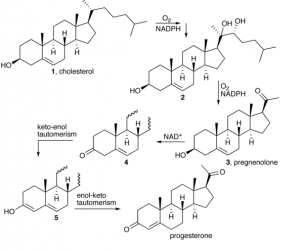Also see:
PUFA Accumulation & Aging
Fish Oil and Lipid Peroxidation
If our purpose is to delay the menopausal rise of the gonadotrophins, then it is interesting that lipid peroxidation of polyunsaturated fatty acids (which increases with age) can be intimately involved in loss of progesterone forming ability by human steroidogenic tissues. -Ray Peat, PhD
J Steroid Biochem Mol Biol. 1992 Aug;42(7):729-36.
The influence of NADPH-dependent lipid peroxidation on the progesterone biosynthesis in human placental mitochondria.
Klimek J.
In an in vitro system consisting of human term placental mitochondria and an NADPH-generating system plus Fe2+, significant lipid peroxidation was observed along with a concomitant inhibition of progesterone biosynthesis. This inhibition could be markedly blocked by Mn2+, superoxide dismutase and dimethylfuran, inhibitors of NADPH-dependent lipid peroxidation. In addition, it has been found that malondialdehyde formation is accompanied by a corresponding decrease in placental mitochondrial cytochrome P-450 content. Inhibitors of lipid peroxidation also prevent the loss of cytochrome P-450, further demonstrating a direct relationship between NADPH-dependent lipid peroxidation and degradation of cytochrome P-450 in cell-free systems. These measurements provide the first evidence that the inhibition of progesterone biosynthesis by a NADPH-dependent lipid peroxidation in placental mitochondria is a consequence of cytochrome P-450 degradation due to lipid peroxidation.

